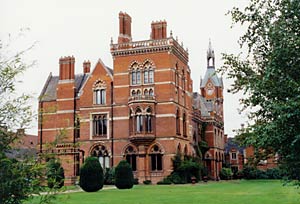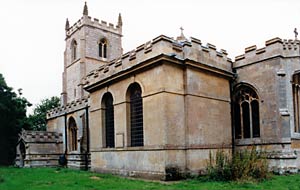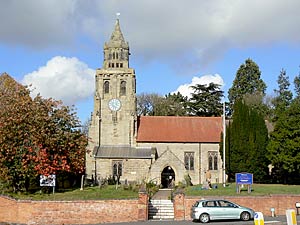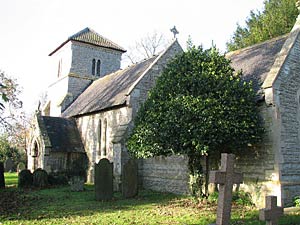< Previous | Contents | Next >
A Masterpiece of Sargeant Jagger

Kelham Hall in 2000.
KELHAM. Attractive with winding ways and lovely trees, and the Trent flowing swiftly through spacious meadows, Kelham has memories of a famous family, and of a king who gave himself up to the Scots near by; and it has something of today which is one of the surprises of this countryside.
Some of its old things are gone. A five-arched brick bridge spans the river where an older bridge was cut in two by a sheet of ice last century; and a great brick house built by Sir Gilbert Scott has taken the place of the hall burned down in 1857, which itself had followed a Stuart house destroyed by fire at the close of the 17th century. In the old house Charles Stuart is said to have been held captive after surrendering to the Scottish army encamped near the village. Now the great house is a Theological College, which has built for itself a chapel like no other church we have seen. It was still an unfinished building when we called, though completed for the time being, and in use. Its unsuspected beauty is inside, strikingly impressive with many round arches, soft light from round-headed windows, and a simple but charming colour scheme. A great grey dome looks down on walls of yellowy red brick as the builders left them, and an apse of deep amethyst is a fine background for a great bronze Crucifixion scene, a masterpiece of Charles Sargeant Jagger; Mary and John are below the Cross, both of them fine, and Mary a dramatic figure. The lamps, the altar, and the beautiful plate are all the work of Alexander Fisher.

Kelham church in 2000.
The old church of St Wilfrid is close to the college, in company with fine trees and playing-fields. A splendid elm overtops the tower, and a good old yew is near the porch, which shelters an ancient studded door; on the hood of the doorway are two quaint heads, inside the church.
Coming chiefly from the last years of the 15th century, the church is pleasing and light, with aisles, a lofty tower arch with embattled capitals, an old font, a few old glass fragments, a fine old roof in the north aisle, and stone corbels at the ends of the chancel beams, carved with flowers, heads of women, angels, and grotesque smiling animals. The traceried screens across the chancel arch and the south chapel are 15th century.
Here in the church we are reminded of the Manners and the Manners-Suttons who lived for a time at Kelham Hall. Robert Sutton was made Baron Lexington for his loyalty in the Civil War, and took his title from the name of his ancestors, three Lexington brothers famous in the 13th century. Robert Sutton, the second and last Lord Lexington, was a diplomat who, while ambassador at Madrid, lost his only son at 15: the boy's body was brought to England in a bale of cloth and buried here at Kelham. We read of him on the ponderous marble monument of his parents, where the more than lifesize figures of Lord Lexington and his wife are reclining on a mattress, both in richly ornamented robes and sandals, Lord Lexington holds his coronet, and a long inscription tells of his family and his career.
The Lexington Papers, comprising the correspondence of the second Lord Lexington with various public men, were discovered at Kelham Hall, and were published in 1851.
The Beacon Beautiful

Keyworth church in 2011.
© Copyright Alan Murray-Rust and licensed for reuse under this Creative Commons Licence
KEYWORTH. Its two things to see are the fine views of the Wolds and the wooded countryside, and the charming little church in a halo of trees, covered with creeper when we called. On the edge of the village is a forlorn old windmill.
Though much restored, the church has an ancient story, told by a Norman font nearly three yards round, and a beacon tower of rare design and exceptional beauty. Built about the end of the 14th century, and conspicuous for miles, the tower was used to guide travellers over the Wolds, and in times of danger as a signal station communicating with Nottingham, Belvoir Castle, and Charnwood Forest. Beautiful buttresses, stepped and gabled, strengthen it at the angles, and crowning it all is an embattled stone lantern with eight sides, little windows, and a tiny spire.
Charming as it is outside, the tower is no less pleasing within, where its lofty arch opens to the nave, and a small arch in its north and south walls lead to the extended aisles. This unusual arrangement made it possible to hold the village school here last century.
The 13th century chancel has a 14th century window with a sill forming stone seats, but the east window and the arch are modern. The old arcade still divides the 14th century nave and aisle.

Kilvington church in 2005.
© Copyright Bob Danylec and licensed for reuse under this Creative Commons Licence
KILVINGTON. It is only a few dwellings and a tiny church on a border hilltop, but it has a glorious prospect over the Vale of Belvoir and into Lincolnshire.
The church comes from the middle of last century, after the death of a rector who had allowed the old building to fall into ruin. With Staunton half a mile away, he thought Kilvington had no need of its own church, which was used for a time as a sheep-fold, and was actually offered for sale as building material. Its one ancient relic is a worn chalice and paten of thin pewter, dug up 40 years ago after having been buried with a priest before the Reformation.
KIMBERLEY. Coal, beer, and hosiery have made it what it is, a workaday place with a domed shrine, surmounted by a clock, sheltering the names of men who died in the Great War. To Captain Sydney Hanson, drowned when the Leasowe Castle was torpedoed in 1918, there is a window in the 19th century stone church, which has a school for company at the foot of the hill.
